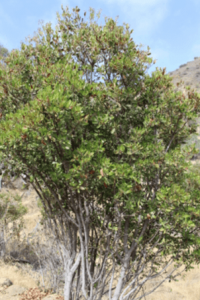
 With so little water in Southern California right now, especially on Catalina Island, plants that are adapted to droughts are definitely surviving the dry heat better than others. Toyon tree (Heteromeles arbutifoloia) is a shrub-like tree that is native to Catalina Island, and tolerant of extreme drought conditions. It is found along the California coast of the mainland as well, and is also commonly called Christmas berry or California holly. This tree is actually part of the rose family and typically grows 8-15 feet tall depending on the amount of sunlight that it is exposed to. The tree has small, toothed leaves that tend to stiffly point upward as they are very thick to tolerate little water.
With so little water in Southern California right now, especially on Catalina Island, plants that are adapted to droughts are definitely surviving the dry heat better than others. Toyon tree (Heteromeles arbutifoloia) is a shrub-like tree that is native to Catalina Island, and tolerant of extreme drought conditions. It is found along the California coast of the mainland as well, and is also commonly called Christmas berry or California holly. This tree is actually part of the rose family and typically grows 8-15 feet tall depending on the amount of sunlight that it is exposed to. The tree has small, toothed leaves that tend to stiffly point upward as they are very thick to tolerate little water.
Throughout the summertime Toyon tree produces white flowers that eventually turn into small red berries in the late fall and winter, similar looking to holly, hence the nickname. Because Toyon tree is so plentiful in chapparal areas, the famous “Hollywood” region was named for the presence of this plant, as it was mistaken for a different red-berried plant, Holly. In the 1920s, Toyon tree was even collected so much in the Los Angeles area during Christmas time that a law was passed to forbid its collection on public lands. More recently, it was adopted as the official native plant for the city of Los Angeles in 2012.
 Toyon tree was named by the Oholone tribe and was used by many California tribes including the Tongva for food and medicine. It is the only plant native to California that still goes by its Native American name. Often it was dried, used to make a tea for stomachaches, or made into a jelly. For other wildlife, it is an important plant for bees and butterflies, and provides fruit for many bird species, coyotes, and bears. The berries start off a bright green color and contain toxins, which keep predators away until they are mature. Once they turn a deep red, the toxins lessen, and the animals are attracted to them, consume them, and help to spread the seeds. Another important characteristic of the plant is their deep, net-like root system, which helps to prevent erosion for dry, hilly landscapes. All in all, it is a beautiful plant that flourishes throughout Catalina, think of Toyon Bay!
Toyon tree was named by the Oholone tribe and was used by many California tribes including the Tongva for food and medicine. It is the only plant native to California that still goes by its Native American name. Often it was dried, used to make a tea for stomachaches, or made into a jelly. For other wildlife, it is an important plant for bees and butterflies, and provides fruit for many bird species, coyotes, and bears. The berries start off a bright green color and contain toxins, which keep predators away until they are mature. Once they turn a deep red, the toxins lessen, and the animals are attracted to them, consume them, and help to spread the seeds. Another important characteristic of the plant is their deep, net-like root system, which helps to prevent erosion for dry, hilly landscapes. All in all, it is a beautiful plant that flourishes throughout Catalina, think of Toyon Bay!
Written By: Jaclyn Lucas


